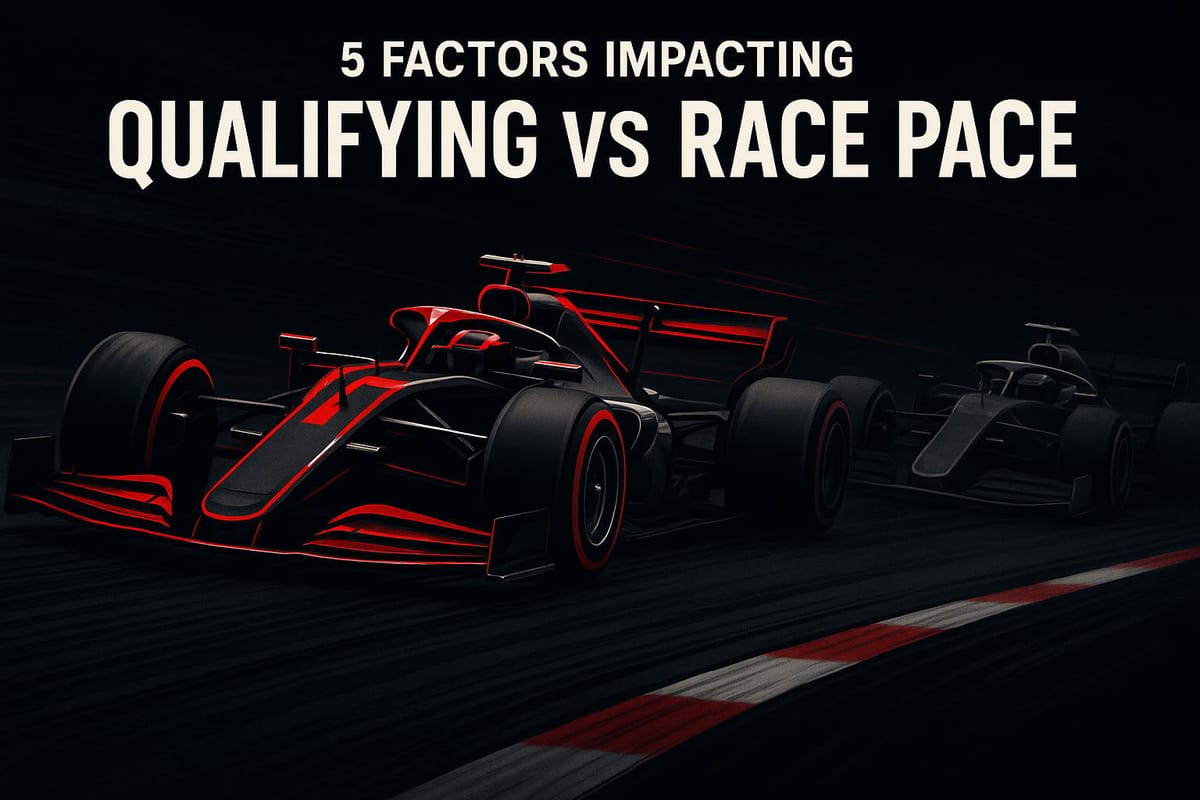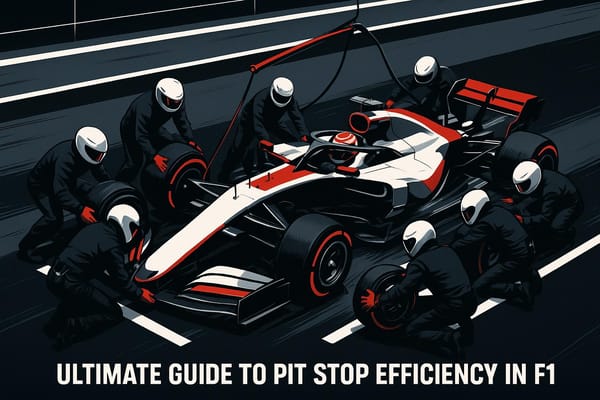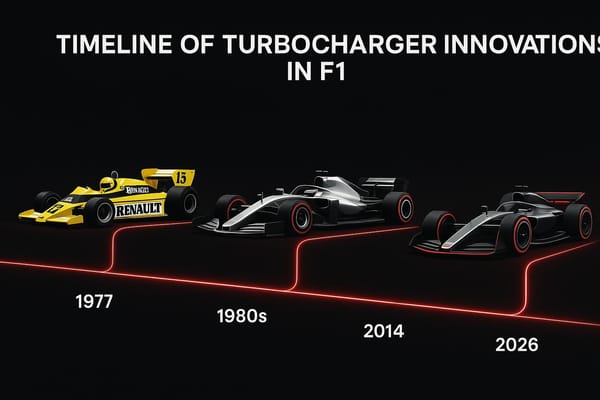5 Factors Impacting Qualifying vs Race Pace
Explore the five key factors that differentiate qualifying and race pace in Formula 1, from fuel load to driver strategy.

Formula 1 cars perform differently during qualifying and races due to five key factors:
- Fuel Load and Weight: Cars run light on fuel in qualifying for speed, but heavy fuel loads in races slow them down.
- Tires: Softer tires provide grip for short qualifying runs but degrade quickly, while harder compounds last longer in races.
- Engine Settings: Engines are pushed to maximum output in qualifying but are tuned for durability during races.
- Car Setup: Qualifying setups prioritize speed, whereas race setups focus on balance and endurance.
- Driver Approach: Qualifying demands aggressive, risk-taking driving; races require measured, strategic decisions.
These factors explain why some cars excel in qualifying but struggle in races, while others perform better over long distances. By balancing these elements, teams aim to optimize performance across the weekend.
F1 CRASH COURSE | Quali Pace vs Race Pace | What are the Differences?
1. Fuel Load and Car Weight
One of the biggest differences between qualifying and race performance in Formula 1 comes down to fuel load. During qualifying, teams run their cars with as little fuel as possible - just enough to complete their flying lap and meet the FIA’s mandatory 1-liter reserve for fuel sampling. This minimal fuel load significantly reduces the car’s weight, allowing for maximum speed and agility.
In contrast, race cars carry much heavier fuel loads to cover the full Grand Prix distance. Regulations currently permit up to 110 kg of fuel for a race, though teams often calculate fuel loads strategically, sometimes under-fueling by 5–15 kg to gain a performance edge. This extra weight has a noticeable impact on performance.
For example, at the 2020 Bahrain Grand Prix, the difference between a low-fuel qualifying lap (1:27.264) and a typical race lap (1:32.014) was nearly 5 seconds. On average, cars lose about one-tenth of a second per lap for each liter of fuel onboard, or roughly 3 tenths for every 10 kg of weight, depending on the track layout. The added weight also shifts the car’s handling characteristics, making it less nimble.
A heavily fueled car brakes earlier, accelerates more slowly out of corners, and feels less responsive compared to its lightweight qualifying setup.
Evolution of Fuel Regulations
Fuel regulations have evolved significantly over the years. Since 2014, the maximum fuel limit has increased from 100 kg to 110 kg, reflecting changes like heavier tires, the introduction of the Halo safety device, and the need for fuel-saving techniques like "lift-and-coast". Interestingly, in older cars, fuel made up a larger percentage of the car's total weight, making it easier to visually gauge fuel loads - something that’s much harder to detect with modern F1 cars.
David Tsurusaki, ExxonMobil’s global motorsports technology manager, highlights the precision required in developing F1 fuel:
"In the case of an elite-level motorsport like F1, we're formulating a fuel to work with that specific engine, optimising the performance to the last degree. When the engine supplier alters the spec even slightly – perhaps a small change to the compression ratio or something of that order, it's going to make the engine run differently and we're going to adjust the fuel to maximise the performance."
Fuel Burn-Off and Lap Time Gains
As the race progresses and fuel burns off, cars become lighter and faster. Over the course of a typical 60-lap Grand Prix, lap times can improve by 3–4 seconds due to the reduced fuel weight. This translates to about 5–6 hundredths of a second per lap - a small but critical improvement that can make all the difference in a race.
2. Tire Selection and Wear
In Formula 1, the choice of tire compound plays a huge role in the difference between qualifying and race pace. Teams face a tough decision: softer compounds provide maximum grip for short, high-speed qualifying laps, while harder compounds are built for durability over longer race distances. Pirelli supplies three options - soft, medium, and hard - each designed to balance performance and longevity. The soft compound often delivers a clear lap time advantage during qualifying but wears out much faster. While soft tires shine for a few laps, harder compounds maintain a consistent pace over extended stints.
During qualifying, drivers push soft tires to their limits. These tires heat up quickly, offering better braking and faster cornering speeds. However, this intense performance comes at a cost - rapid tire degradation, making soft compounds less practical for long race stints.
The Degradation Challenge
Managing tire wear is a cornerstone of race strategy. As tires degrade, lap times inevitably slow down, with the rate of wear depending on factors like track conditions and weather. High-temperature tracks like Singapore or Hungary tend to accelerate tire degradation, whereas cooler venues like Silverstone or Spa-Francorchamps are easier on the rubber. Tires can also hit a performance "cliff", a sudden and dramatic drop-off, forcing teams to carefully time their pit stops to maximize the advantage of fresh tires while minimizing time lost in the pits.
Another challenge comes from the aerodynamic wake created by modern F1 cars. This "dirty air" disrupts airflow for trailing cars, making it harder for them to keep their tires at the ideal temperature. While this is less of an issue in qualifying, where cars run in clean air, it can significantly impact tire wear during the race, further complicating the balance between pace and longevity.
Strategic Implications
To navigate these challenges, teams craft strategies that balance tire performance with durability. Drivers who make it to the final qualifying session (Q3) must start the race on the same compound they used for their fastest lap, which forces teams to weigh grid position against race endurance. On race day, managing tire temperatures becomes critical. If the tires overheat, degradation speeds up; if they’re too cool, they lose grip. Race engineers and drivers work closely throughout the race, constantly adjusting to keep the tires within their optimal temperature range. This balancing act is key to ensuring both competitive pace and tire longevity over the course of the race.
3. Engine Power Settings
F1 power units are designed with multiple modes, allowing teams to tweak performance based on their race strategy. For qualifying sessions, teams push both the combustion engine and hybrid systems to their limits, aiming for maximum output over a short period. This approach delivers peak performance but generates significant heat and strain, making it unsuitable for an entire race.
During the race, engine settings are adjusted to prioritize durability and efficiency. Teams reserve higher power modes for key moments, like overtaking or defending position. In hotter conditions, more conservative settings help manage heat buildup, while cooler weather gives teams the freedom to push the engine harder.
This meticulous approach to engine management underscores the fine line teams walk to optimize performance across both qualifying and race day.
4. Car Setup and Aerodynamic Configuration
The car's aerodynamic and mechanical setups can vary significantly between qualifying and race conditions. Teams have to juggle a critical trade-off: chasing maximum speed for a single flying lap versus ensuring balanced performance over an entire race.
For qualifying, setups are all about raw speed. Teams go for low-drag configurations, often reducing the rear wing angles to cut down on air resistance along the straights. This approach shaves valuable tenths of a second off lap times but comes at a cost - reduced downforce, which impacts cornering and braking performance.
Suspension settings also play a key role. During qualifying, teams typically opt for lower ride heights and stiffer suspension. A lower ride height enhances the car's aerodynamic seal, reducing turbulence under the car, which improves straight-line speed. However, this setup prioritizes speed over comfort and control, making it less suited for race conditions.
Race setups, on the other hand, aim for a balance between speed and endurance. Higher downforce settings are often used to reduce tire wear and ensure consistent lap times as the race progresses and fuel loads decrease. The added grip helps drivers maintain control during intense wheel-to-wheel battles, even when driving in disrupted air behind other cars.
Mechanical grip becomes equally important for race pace. Teams tweak differential settings, brake balance, and suspension geometry to adapt to the shifting dynamics of a car as its fuel load drops. These adjustments ensure the car remains competitive throughout the race, bridging the gap between the explosiveness of qualifying and the consistency needed for race day.
Track characteristics further complicate these decisions. High-speed circuits like Monza demand low-drag setups for qualifying, while twisty tracks like Monaco require maximum downforce, even during qualifying. Weather conditions can also throw a wrench into plans. A wet session might force teams to abandon their original setup strategies entirely.
Adding to the challenge, parc fermé rules now require teams to use a single compromise setup for both qualifying and the race. This forces engineers to strike a delicate balance between outright speed for qualifying and durability for race performance.
5. Driver Approach and Race Conditions
The demands placed on drivers vary significantly between qualifying sessions and race conditions. Qualifying is all about pushing the car to its absolute limits, aiming for that single, flawless lap. Drivers go all-in, often operating at a level that's unsustainable over an entire race. On race day, however, the approach shifts to a more calculated and strategic effort, balancing speed with tire conservation, fuel efficiency, and positioning on the track.
In qualifying, every fraction of a second matters. Drivers brake later, carry more speed through corners, and take risks they’d never consider during a race. With the car running on low fuel and equipped with fresh tires, its behavior becomes more predictable, giving drivers the confidence to attack each corner aggressively. This heightened intensity underscores the critical nature of qualifying laps, where even the smallest mistake can mean the difference between pole position and starting mid-pack.
Track conditions also play a pivotal role in qualifying. As more cars complete laps, rubber builds up on the racing line, increasing grip. This evolving track surface adds pressure on drivers to deliver their best performance at just the right moment, knowing that a single error could cost them dearly.
Race conditions, on the other hand, demand a completely different mindset. Drivers must focus on tire management, navigating traffic, and adapting their pace to the car’s condition. As tires degrade, braking points and throttle application need to be adjusted, requiring a more measured and strategic approach. Traffic further complicates the picture, as following other cars disrupts aerodynamics, reducing downforce and forcing drivers to modify their cornering techniques compared to the clean-air runs of qualifying.
Fuel loads also play a major role in shaping race strategy. At the start of a race, the car is heavier, which affects braking distances and cornering speeds. As fuel burns off over time, the car becomes lighter and more responsive, allowing drivers to push harder in the later stages - if they’ve managed their tires wisely.
Weather can throw an additional curveball into the mix. A sudden rain shower can completely upend the competitive order, forcing drivers to adapt on the fly. Wet conditions often level the playing field, giving skilled drivers in less dominant cars a chance to shine through superior handling and racecraft.
The mental challenges also shift dramatically between qualifying and race day. While qualifying is all about raw speed and risk-taking, races require patience and a long-term view. Drivers must resist the urge to fight for every position immediately, instead waiting for opportunities to present themselves naturally as the race unfolds.
Communication with the pit crew becomes a crucial factor during races. Unlike qualifying, where the focus is solely on extracting maximum performance, race communication involves constant updates on tire performance, track conditions, and competitor behavior. This real-time feedback allows teams to adjust strategies on the fly, helping drivers navigate the ever-changing dynamics of a race.
Conclusion
The difference between qualifying and race pace in Formula One is shaped by a mix of technical, strategic, and human factors that highlight the sport's complexity. The five key elements we’ve discussed - fuel load and car weight, tire selection and wear, engine power settings, car setup and aerodynamic configuration, and driver approach and race conditions - all contribute to performance gaps that can amount to several seconds per lap.
These factors explain why some teams shine in qualifying but struggle during the race, or why certain cars perform better over longer distances. A prime example is the 2022 Hungarian Grand Prix, where Lando Norris secured fourth in qualifying, ahead of faster race cars, thanks to McLaren’s focus on short-term performance. However, during the race, he couldn’t maintain that pace and finished behind rivals with stronger race setups.
McLaren’s Andreas Seidl has noted that some teams can "mask" weaknesses like limited downforce during qualifying, only for those shortcomings to surface over a race distance. This highlights the importance of building a car that performs well in all conditions and the need for strategic flexibility to maximize results across the weekend.
Balancing a car’s setup for qualifying and race conditions is a strategic juggling act. Teams must weigh the benefits of securing a strong grid position against ensuring competitive race performance. This balance not only influences race outcomes but also adds another layer of excitement for fans.
For those watching, understanding these intricacies transforms Formula One from just a spectacle of speed into a strategic battle between teams, drivers, and engineers. It helps fans interpret why a driver who excels in qualifying may falter on race day or why a slower qualifier can climb through the field on Sunday.
What makes Formula One so captivating is how these elements interact over a race weekend. A team’s ability to optimize across all five areas - whether it’s fuel strategy or a driver’s mental approach - often determines who stands on the podium and who doesn’t. As the sport evolves with new regulations and strategies, these core principles remain central to what makes Formula One the ultimate test of engineering and competition.
For a deeper dive into how teams navigate the balance between qualifying and race strategies, resources like F1 Briefing offer expert analysis that brings fans closer to the action and decisions shaping the sport.
FAQs
How do F1 teams determine the best fuel load for a race without sacrificing performance?
How F1 Teams Manage Fuel for Peak Performance
F1 teams put a lot of thought into determining the perfect fuel load for a race. Too much fuel? The car gets heavier, slowing it down. Too little? The car might not make it to the finish line. To strike this balance, teams usually start with slightly less fuel than the tank's maximum capacity - around 4 to 22 pounds (2 to 10 kg) less. This helps the car accelerate faster and handle better on the track.
During the race, teams rely on real-time telemetry data to keep a close eye on fuel consumption and engine performance. With this information, they tweak engine settings and guide drivers on strategies to get the most out of every drop of fuel. This careful monitoring and adjustment ensure the car remains fast and efficient, completing the race without carrying excess weight or running out of fuel.
How do F1 drivers and teams manage tire wear during a race?
How F1 Drivers and Teams Manage Tire Wear
In Formula 1, managing tire wear is a delicate balancing act that can make or break a race. Drivers adapt their techniques, such as braking gently and cornering smoothly, to reduce sliding and overheating. These adjustments help keep tire degradation under control, ensuring better performance over the long haul.
Meanwhile, teams focus on fine-tuning the car's setup. Adjustments to brake bias and aerodynamic settings help maintain the tires at their ideal temperature range. On top of that, strategic decisions - like selecting the best tire compounds and nailing the timing of pit stops - are key to finding the sweet spot between speed and durability. Together, these efforts allow drivers to stay competitive while saving their tires for those critical moments when it matters most.
Why do engine power settings differ between qualifying and race sessions, and how does this affect performance?
In Formula 1, teams fine-tune engine power settings based on the unique demands of qualifying and race sessions. For qualifying, engines are pushed to their limits using a 'high-power mode.' This setting is all about squeezing out maximum speed to clock the fastest lap times. Since it’s only used for a handful of laps, durability takes a backseat to raw performance.
Race day tells a different story. Engines are dialed back to more conservative settings, prioritizing reliability over peak performance. This approach helps manage fuel consumption and reduces wear on the engine, ensuring it can last the entire race distance. These adjustments don’t just affect raw speed - they play a crucial role in tire management and shaping the overall race strategy. Teams are constantly balancing the need for speed with the demands of endurance.




